Country guides

Things to do in Armenia
Armenia is a country full of surprises, often overlooked by travellers despite its rich history and stunning landscapes. As the first nation in the world to adopt Christianity as a state religion, it's home to countless ancient churches and monasteries, but is noteworthy for its dramatic scenery, vibrant culture and warm hospitality as well.
One of the most iconic landmarks is Khor Virap Monastery, which is set against the striking backdrop of Mount Ararat. According to tradition, this is where Noah's Ark came to rest. Although the mountain lies in modern-day Turkey, it remains a powerful symbol for Armenians and is clearly visible from many parts of the country. Another major religious site is Etchmiadzin Cathedral, considered the oldest state-built church in the world and still the spiritual centre of the Armenian Apostolic Church.
Armenia's pre-Christian heritage is also well preserved. The 1st-century Garni Temple, a rare example of Greco-Roman architecture in the region, stands proudly above a dramatic gorge. Nearby, the UNESCO-listed Geghard Monastery is partly carved into the mountainside and surrounded by cliffs. For something even older, Carahunge, a prehistoric site often compared to Stonehenge, offers a glimpse into Armenia's ancient past.
In northern Armenia, the scenic Debed Canyon winds past charming villages and historic monasteries such as Haghpat and Sanahin, both recognised as UNESCO World Heritage Sites. In the capital, Yerevan, visitors can explore the ancient Erebuni Fortress, founded in 782 BC by the kings of Urartu. South of the capital, Noravank Monastery provides one of the country's most memorable views, especially at sunset when the surrounding red cliffs glow with colour.
Modern Armenian history is deeply shaped by the 1915 genocide, during which approximately 1.5 million Armenians were killed under the Ottoman Empire. The Tsitsernakaberd Memorial and Museum in Yerevan features a moving tribute to the victims and provides important context for understanding Armenia today.
Whether interested in religion, archaeology, nature or culture, visitors to Armenia will find a destination full of depth, beauty and stories waiting to be discovered.
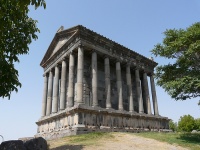
Garni Temple
The Garni Temple is Armenia's only surviving pagan temple and a major tourist attraction in the village of Garni. Built in the 1st century AD in the Ionic style, it was part of a r…
Garni Temple
The Garni Temple is Armenia's only surviving pagan temple and a major tourist attraction in the village of Garni. Built in the 1st century AD in the Ionic style, it was part of a royal summer residence that included a palace, bathhouse and other structures. Perched above the Azat River Gorge, the temple was destroyed by an earthquake in 1679 and later reconstructed in the 20th century using many original stones. Today, visitors can explore the site's impressive architecture and ongoing archaeological excavations, which continue to uncover artefacts from Armenia's pre-Christian and early Christian eras.
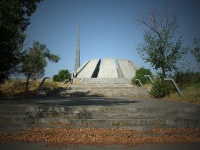
Tsitsernakaberd (Genocide Museum and Memorial)
Tsitsernakaberd is Armenia's official memorial to the victims of the 1915 Armenian Genocide, which took place in the Ottoman Empire. It's estimated that approximately 1.5 million A…
Tsitsernakaberd (Genocide Museum and Memorial)
Tsitsernakaberd is Armenia's official memorial to the victims of the 1915 Armenian Genocide, which took place in the Ottoman Empire. It's estimated that approximately 1.5 million Armenians were killed. The monument consists of two symbolic structures: a 140-foot (44m) stele representing the national rebirth of the Armenian people, and a circular arrangement of 12 basalt slabs symbolising the twelve Armenian-populated provinces lost to modern-day Turkey. Each year on April 24, Genocide Remembrance Day, hundreds of thousands gather here to lay flowers in tribute. The adjacent museum tells the story of the genocide through photos, documents, survivor testimonies and media reports.
Website www.genocide-museum.am
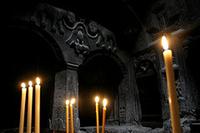
The Monastery of Geghard
The Monastery of Geghard, meaning 'Monastery of the Spear', is one of Armenia's most remarkable landmarks. Partially carved into the cliffs of the Azat River gorge, the site combin…
The Monastery of Geghard
The Monastery of Geghard, meaning 'Monastery of the Spear', is one of Armenia's most remarkable landmarks. Partially carved into the cliffs of the Azat River gorge, the site combines natural beauty with extraordinary medieval architecture. While an early monastery was established here in the 4th century at the site of a sacred spring, the main chapel that stands today was built in 1215. The monastery takes its name from the Holy Lance, the spear said to have pierced Christ's side, which, according to tradition, was brought to Armenia by the Apostle Thaddeus. Geghard's blend of rock-hewn chapels, acoustics and historical depth make it both a spiritual and architectural masterpiece.
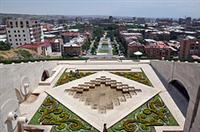
Cafesjian Center for the Arts
Yerevan's Cascade Complex is a massive limestone stairway built into the hillside, designed with fountains and gardens to resemble a natural cascade. It connects the city centre wi…
Cafesjian Center for the Arts
Yerevan's Cascade Complex is a massive limestone stairway built into the hillside, designed with fountains and gardens to resemble a natural cascade. It connects the city centre with the Monument neighbourhood and Victory Park above. More than just a striking piece of architecture, the Cascade is also a cultural hub, home to the Cafesjian Center for the Arts and host to free outdoor concerts, exhibitions, and events, especially in warmer months. Visitors can walk or jog along its terraces, relax in nearby parks, or simply enjoy panoramic views of Mount Ararat and central Yerevan. The Cascade is both a landmark and a lively public space in the heart of Armenia's capital.
Website www.cmf.am
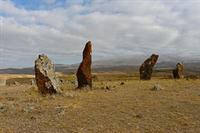
Carahunge
Carahunge, also known as Zorats Karer, is a mysterious megalithic site in southern Armenia made up of over 200 standing stones arranged across a windswept plateau near Sisian. Ofte…
Carahunge
Carahunge, also known as Zorats Karer, is a mysterious megalithic site in southern Armenia made up of over 200 standing stones arranged across a windswept plateau near Sisian. Often called 'Armenia's Stonehenge', some researchers believe it may have functioned as an ancient astronomical observatory, pointing to a number of stones with circular holes possibly aligned with celestial events. While some claim the site dates back as far as 5500 BCE, others suggest it may be from the Bronze or Iron Age, making its true age the subject of ongoing debate. Regardless, Carahunge remains one of Armenia's most enigmatic and atmospheric historic sites.
Website www.carahunge.com


